Herb Article
Yerba Santa
By Tzuria Malpica, Certified Clinical Herbalist
 Herb
Herb
Yerba Santa, Eriodictyon californicum
Parts used
Dried leaf
Medicinal Properties
First used by Native American healers and later by Spanish settlers, Yerba Santa has been considered a valuable herbal remedy for centuries. The name means "Holy or Sacred Herb". One of its signature characteristics is the leathery, resinous leaves which help to hold moisture inside the plant and protect it from the intensity of its environment. Yerba Santa is in the Waterleaf family (Hydrophyllaceae) and is native to the Southwestern regions of North America and parts of northern Mexico. Its strong affiliation with the element of water tells us about many of is medicinal uses.
Historically, Yerba Santa is known as one of the best decongestants useful for lung or sinus conditions that are "juicy" or moist. It can be helpful in cases of asthma and runny nose accompanied by a cold or sinus allergies. As an expectorant, Yerba Santa can help to loosen phlegm and bringing it up and out of the respiratory tract. Using too much can sometimes over-dry the membranes, therefore combining it with moistening herbs is often advised.
Herbalist Michael Moore says that Yerba Santa is useful for soothing chronic gastritis and urethral irritation. He writes that it will also promote salivation and stimulate the digestion, making it quite helpful when there is a loss of appetite accompanying illness. Externally, Yerba Santa can be applied to bruises, sprains, bites and rheumatic pains. It is also used externally to soothe rashes such as poison oak or poison ivy, mosquito bites, and is found to be beneficial for wounds.
As an emotional remedy, Yerba Santa is excellent for people experiencing grief, despair or melancholy. According to some traditions, these emotions are stored in the heart and the lungs, making Yerba Santa a good fit. Supporting the respiratory region, this sacred herb is used to free the breath, heart, and lungs which aids in the release of stored emotions. Sometimes burned in ceremony, Yerba Santa nourishes and protects the wild parts in one's self. It can be used when in need of encouragement and courage. Preparations and Applications: Yerba Santa is best as a tea, tincture, or syrup. The herb may also be prepared externally as a poultice, wash, or bath.
Preparations and Applications
Yerba Santa is best as a tea, tincture, or syrup. The herb may also be prepared externally as a poultice, wash, or bath.
Recipe
Seasonal Allergy Tea
2 parts Yerba Santa
2 parts Nettles
1 part Rosehips
1 part Spearmint
1/2 part Licorice
Use 1 Tablespoon of tea per cup of water. Steep for approximately 35 minutes, strain and enjoy. Drink 2-4 cups daily to help relieve seasonal allergies.
Resources
Planetary Herbology by Michael Tierra
The Earthwise Herbal: A Complete Guide to New World Medicinal Plants by Mathew Wood
Herbal Vade Mecum by Gazmend Skenderi
Medicinal Plants of the Mountain West by Michael Moore
Flower Essence Society (Article) Yerba Santa Eriodictyon californicum by Patricia Kaminski and Richard Katz
 Herb
HerbYerba Santa, Eriodictyon californicum
Parts used
Dried leaf
Medicinal Properties
First used by Native American healers and later by Spanish settlers, Yerba Santa has been considered a valuable herbal remedy for centuries. The name means "Holy or Sacred Herb". One of its signature characteristics is the leathery, resinous leaves which help to hold moisture inside the plant and protect it from the intensity of its environment. Yerba Santa is in the Waterleaf family (Hydrophyllaceae) and is native to the Southwestern regions of North America and parts of northern Mexico. Its strong affiliation with the element of water tells us about many of is medicinal uses.
Historically, Yerba Santa is known as one of the best decongestants useful for lung or sinus conditions that are "juicy" or moist. It can be helpful in cases of asthma and runny nose accompanied by a cold or sinus allergies. As an expectorant, Yerba Santa can help to loosen phlegm and bringing it up and out of the respiratory tract. Using too much can sometimes over-dry the membranes, therefore combining it with moistening herbs is often advised.
Herbalist Michael Moore says that Yerba Santa is useful for soothing chronic gastritis and urethral irritation. He writes that it will also promote salivation and stimulate the digestion, making it quite helpful when there is a loss of appetite accompanying illness. Externally, Yerba Santa can be applied to bruises, sprains, bites and rheumatic pains. It is also used externally to soothe rashes such as poison oak or poison ivy, mosquito bites, and is found to be beneficial for wounds.
As an emotional remedy, Yerba Santa is excellent for people experiencing grief, despair or melancholy. According to some traditions, these emotions are stored in the heart and the lungs, making Yerba Santa a good fit. Supporting the respiratory region, this sacred herb is used to free the breath, heart, and lungs which aids in the release of stored emotions. Sometimes burned in ceremony, Yerba Santa nourishes and protects the wild parts in one's self. It can be used when in need of encouragement and courage. Preparations and Applications: Yerba Santa is best as a tea, tincture, or syrup. The herb may also be prepared externally as a poultice, wash, or bath.
Preparations and Applications
Yerba Santa is best as a tea, tincture, or syrup. The herb may also be prepared externally as a poultice, wash, or bath.
Recipe
Seasonal Allergy Tea
2 parts Yerba Santa
2 parts Nettles
1 part Rosehips
1 part Spearmint
1/2 part Licorice
Use 1 Tablespoon of tea per cup of water. Steep for approximately 35 minutes, strain and enjoy. Drink 2-4 cups daily to help relieve seasonal allergies.
Resources
Planetary Herbology by Michael Tierra
The Earthwise Herbal: A Complete Guide to New World Medicinal Plants by Mathew Wood
Herbal Vade Mecum by Gazmend Skenderi
Medicinal Plants of the Mountain West by Michael Moore
Flower Essence Society (Article) Yerba Santa Eriodictyon californicum by Patricia Kaminski and Richard Katz




